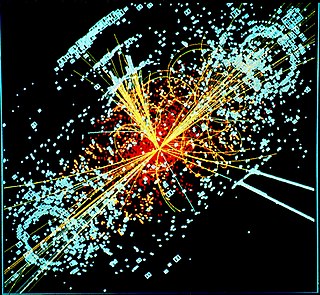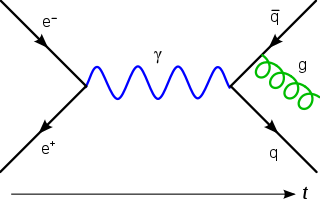
In physics, Kaluza–Klein theory is a classical unified field theory of gravitation and electromagnetism built around the idea of a fifth dimension beyond the common 4D of space and time and considered an important precursor to string theory. In their setup, the vacuum has the usual 3 dimensions of space and one dimension of time but with another microscopic extra spatial dimension in the shape of a tiny circle. Gunnar Nordström had an earlier, similar idea. But in that case, a fifth component was added to the electromagnetic vector potential, representing the Newtonian gravitational potential, and writing the Maxwell equations in five dimensions.
In particle physics, the Dirac equation is a relativistic wave equation derived by British physicist Paul Dirac in 1928. In its free form, or including electromagnetic interactions, it describes all spin-1/2 massive particles, called "Dirac particles", such as electrons and quarks for which parity is a symmetry. It is consistent with both the principles of quantum mechanics and the theory of special relativity, and was the first theory to account fully for special relativity in the context of quantum mechanics. It was validated by accounting for the fine structure of the hydrogen spectrum in a completely rigorous way. It has become vital in the building of the Standard Model.
The Klein–Gordon equation is a relativistic wave equation, related to the Schrödinger equation. It is second-order in space and time and manifestly Lorentz-covariant. It is a differential equation version of the relativistic energy–momentum relation .
In physics and mathematics, the Helmholtz decomposition theorem or the fundamental theorem of vector calculus states that certain differentiable vector fields can be resolved into the sum of an irrotational (curl-free) vector field and a solenoidal (divergence-free) vector field. In physics, often only the decomposition of sufficiently smooth, rapidly decaying vector fields in three dimensions is discussed. It is named after Hermann von Helmholtz.
In the theory of general relativity, linearized gravity is the application of perturbation theory to the metric tensor that describes the geometry of spacetime. As a consequence, linearized gravity is an effective method for modeling the effects of gravity when the gravitational field is weak. The usage of linearized gravity is integral to the study of gravitational waves and weak-field gravitational lensing.
In physics, the gauge covariant derivative is a means of expressing how fields vary from place to place, in a way that respects how the coordinate systems used to describe a physical phenomenon can themselves change from place to place. The gauge covariant derivative is used in many areas of physics, including quantum field theory and fluid dynamics and in a very special way general relativity.
In theoretical physics, massive gravity is a theory of gravity that modifies general relativity by endowing the graviton with a nonzero mass. In the classical theory, this means that gravitational waves obey a massive wave equation and hence travel at speeds below the speed of light.
In theoretical physics, a source field is a background field coupled to the original field as
In theoretical physics, scalar field theory can refer to a relativistically invariant classical or quantum theory of scalar fields. A scalar field is invariant under any Lorentz transformation.

In mathematical physics, the Dirac equation in curved spacetime is a generalization of the Dirac equation from flat spacetime to curved spacetime, a general Lorentzian manifold.
In comparison with General Relativity, dynamic variables of metric-affine gravitation theory are both a pseudo-Riemannian metric and a general linear connection on a world manifold . Metric-affine gravitation theory has been suggested as a natural generalization of Einstein–Cartan theory of gravity with torsion where a linear connection obeys the condition that a covariant derivative of a metric equals zero.
Lagrangian field theory is a formalism in classical field theory. It is the field-theoretic analogue of Lagrangian mechanics. Lagrangian mechanics is used to analyze the motion of a system of discrete particles each with a finite number of degrees of freedom. Lagrangian field theory applies to continua and fields, which have an infinite number of degrees of freedom.
Higher-spin theory or higher-spin gravity is a common name for field theories that contain massless fields of spin greater than two. Usually, the spectrum of such theories contains the graviton as a massless spin-two field, which explains the second name. Massless fields are gauge fields and the theories should be (almost) completely fixed by these higher-spin symmetries. Higher-spin theories are supposed to be consistent quantum theories and, for this reason, to give examples of quantum gravity. Most of the interest in the topic is due to the AdS/CFT correspondence where there is a number of conjectures relating higher-spin theories to weakly coupled conformal field theories. It is important to note that only certain parts of these theories are known at present and not many examples have been worked out in detail except some specific toy models.
In quantum field theory, scalar chromodynamics, also known as scalar quantum chromodynamics or scalar QCD, is a gauge theory consisting of a gauge field coupled to a scalar field. This theory is used experimentally to model the Higgs sector of the Standard Model.
In theoretical physics, more specifically in quantum field theory and supersymmetry, supersymmetric Yang–Mills, also known as super Yang–Mills and abbreviated to SYM, is a supersymmetric generalization of Yang–Mills theory, which is a gauge theory that plays an important part in the mathematical formulation of forces in particle physics. It is a special case of 4D N = 1 global supersymmetry.
In supersymmetry, 4D global supersymmetry is the theory of global supersymmetry in four dimensions with a single supercharge. It consists of an arbitrary number of chiral and vector supermultiplets whose possible interactions are strongly constrained by supersymmetry, with the theory primarily fixed by three functions: the Kähler potential, the superpotential, and the gauge kinetic matrix. Many common models of supersymmetry are special cases of this general theory, such as the Wess–Zumino model, super Yang–Mills theory, and the Minimal Supersymmetric Standard Model. When gravity is included, the result is described by 4D supergravity.
In supersymmetry, 4D supergravity is the theory of supergravity in four dimensions with a single supercharge. It contains exactly one supergravity multiplet, consisting of a graviton and a gravitino, but can also have an arbitrary number of chiral and vector supermultiplets, with supersymmetry imposing stringent constraints on how these can interact. The theory is primarily determined by three functions, those being the Kähler potential, the superpotential, and the gauge kinetic matrix. Many of its properties are strongly linked to the geometry associated to the scalar fields in the chiral multiplets. After the simplest form of this supergravity was first discovered, a theory involving only the supergravity multiplet, the following years saw an effort to incorporate different matter multiplets, with the general action being derived in 1982 by Eugène Cremmer, Sergio Ferrara, Luciano Girardello, and Antonie Van Proeyen.
In supersymmetry, type IIA supergravity is the unique supergravity in ten dimensions with two supercharges of opposite chirality. It was first constructed in 1984 by a dimensional reduction of eleven-dimensional supergravity on a circle. The other supergravities in ten dimensions are type IIB supergravity, which has two supercharges of the same chirality, and type I supergravity, which has a single supercharge. In 1986 a deformation of the theory was discovered which gives mass to one of the fields and is known as massive type IIA supergravity. Type IIA supergravity plays a very important role in string theory as it is the low-energy limit of type IIA string theory.
In supersymmetry, type IIB supergravity is the unique supergravity in ten dimensions with two supercharges of the same chirality. It was first constructed in 1983 by John Schwarz and independently by Paul Howe and Peter West at the level of its equations of motion. While it does not admit a fully covariant action due to the presence of a self-dual field, it can be described by an action if the self-duality condition is imposed by hand on the resulting equations of motion. The other types of supergravity in ten dimensions are type IIA supergravity, which has two supercharges of opposing chirality, and type I supergravity, which has a single supercharge. The theory plays an important role in modern physics since it is the low-energy limit of type IIB string theory.
In supersymmetry, type I supergravity is the theory of supergravity in ten dimensions with a single supercharge. It consists of a single supergravity multiplet and a single Yang–Mills multiplet. The full non-abelian action was first derived in 1983 by George Chapline and Nicholas Manton. Classically the theory can admit any gauge group, but a consistent quantum theory resulting in anomaly cancellation only exists if the gauge group is either or . Both these supergravities are realised as the low-energy limits of string theories, in particular of type I string theory and of the two heterotic string theories.
































